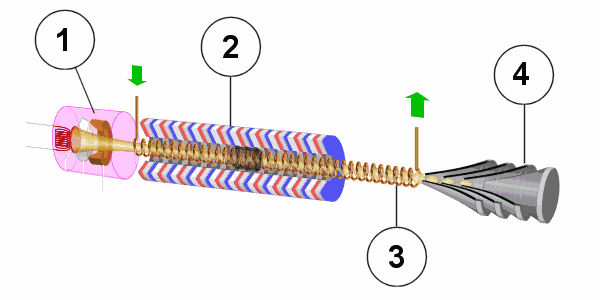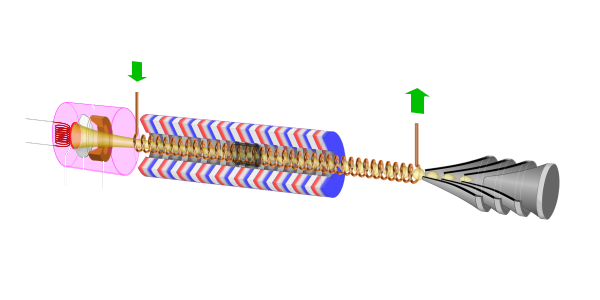History of Traveling Wave Tubes

Figure 1: Physical construction of a TWT: ① Electron gun; ② Surrounding magnet; ③ Slow wave structure (here: Helix); ④ Collector;

Figure 1: Physical construction of a TWT: ① Electron gun; ② Surrounding magnet; ③ Slow wave structure (here: Helix); ④ Collector;
History of Traveling Wave Tubes
Traveling wave tubes are widely used in radar systems and in space communications. The following milestones are significant in the context of the history and development of traveling wave tubes:

Figure 2: Lindenblad's traveling wave amplifier, named to as “Inductive Output Tube”
- Andrew V. Haeff (kyrillic: Андрей Василий Гаев), a Russian electrical engineer working at Radio Corporation of America, described as first the interaction between an electron beam and radio frequency resonators in October 1933. He invented an Inductive Output Tube (IOT)[1] that contained some of the features of a Helix TWT and could be used as detector or oscillograph.
- In Mai 1940 Nils E. Lindblad, working at Radio Corporation of America too, patented a traveling wave amplifier using a helix.[2] But he didn't build a prototype.
- Unaware of Lindenblads work the Englishman Rudolf Kompfner built his first traveling wave tube at Birmingham in 1943. The first publication of this work was made on the Fourth Instuitute of Radio Engineer's (IRE) Tube Conference at Yale in June 1946.
- John Pierce, working at Bell Telephone Laboratories (he was a participant in this conference), developed a working theory of TWT operation[3], based on the interaction between an electron beam and slower electromagnetic waves traveling within the tube.
- Haeff joined the Hughes Aircraft Company in Culver City (California) in 1950 to lead the Electron Tube Laboratory. The Hughes Aircraft Company started designing and building TWTs then.
Sources and ressorces:
- Andrew V Haeff, Patent US 2064469, “Device for and method of controlling high frequency currents” (patents.google.com)
- Nils E. Lindenblad, Patent US 2578434, “High-frequency electron discharge device of the traveling wave type” (patents.google.com)
- John R. Pierce, US Patent 2602148, “High-frequency amplifier” (archive.org)

